Safeway Supermarket Chain: Business Competencies and Landscape Diagram
VerifiedAdded on 2022/12/22
|6
|1915
|52
Project
AI Summary
This project analyzes the business competencies of the Safeway Supermarket chain, focusing on creating an application landscape diagram to illustrate the key business areas and functions. The assignment identifies and describes essential competencies such as contract management, customer management, operations, channel management, group functions, and technology. Each competency is defined with a concise sentence, providing a clear understanding of its role within the Safeway business model. The project explores the interconnectedness of these competencies, highlighting how they contribute to the overall success of the supermarket chain, with considerations for IT services and the supply chain. The application landscape diagram is designed to provide a visual representation of the current application portfolio, and is a vital tool for enterprise architects to analyze how well the existing applications support a new business strategy. The project provides an in-depth look at the various functions and interdependencies that enable Safeway to operate effectively within the retail industry. The work also references relevant academic sources to support the analysis.
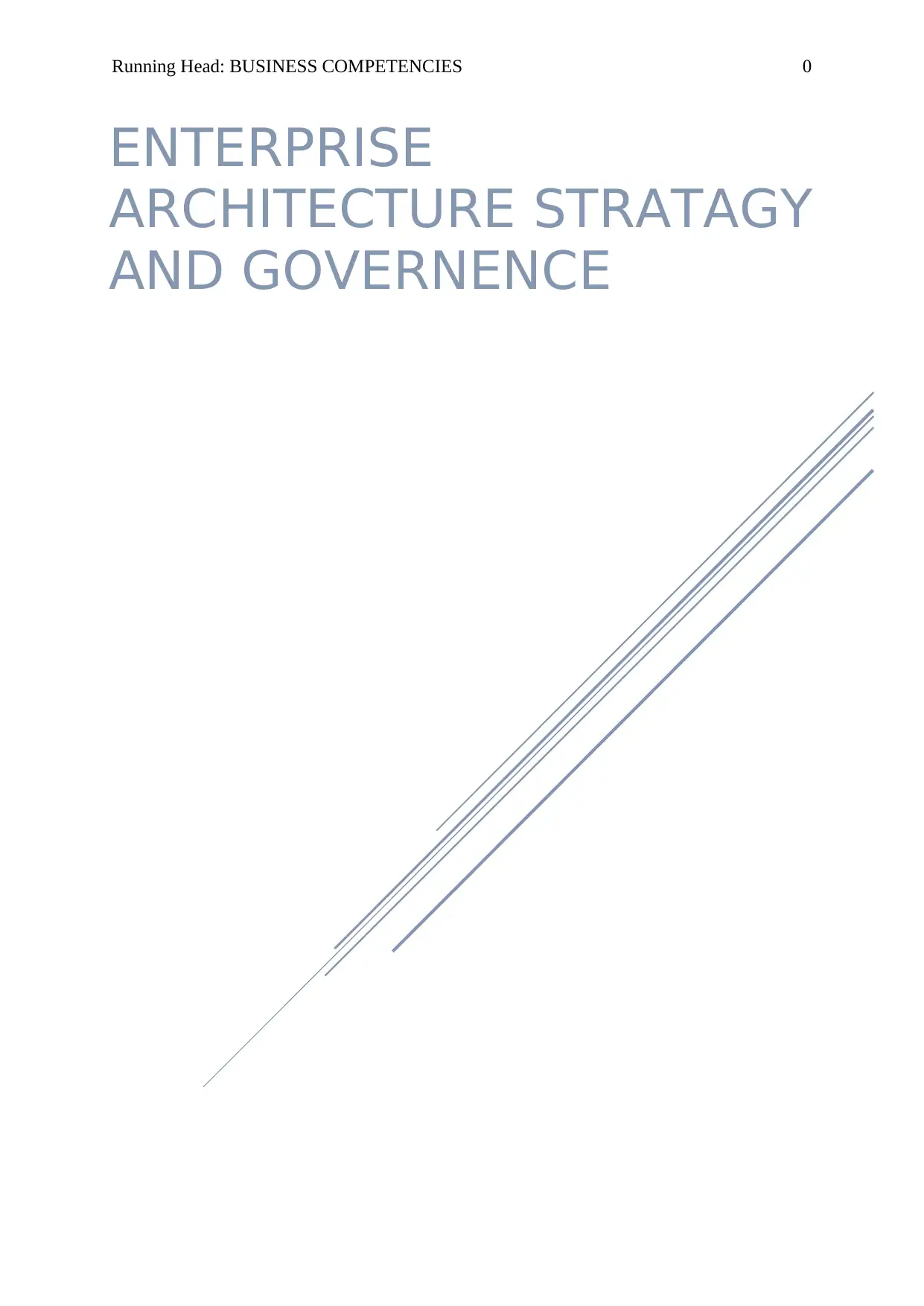
Running Head: BUSINESS COMPETENCIES 0
ENTERPRISE
ARCHITECTURE STRATAGY
AND GOVERNENCE
ENTERPRISE
ARCHITECTURE STRATAGY
AND GOVERNENCE
Paraphrase This Document
Need a fresh take? Get an instant paraphrase of this document with our AI Paraphraser
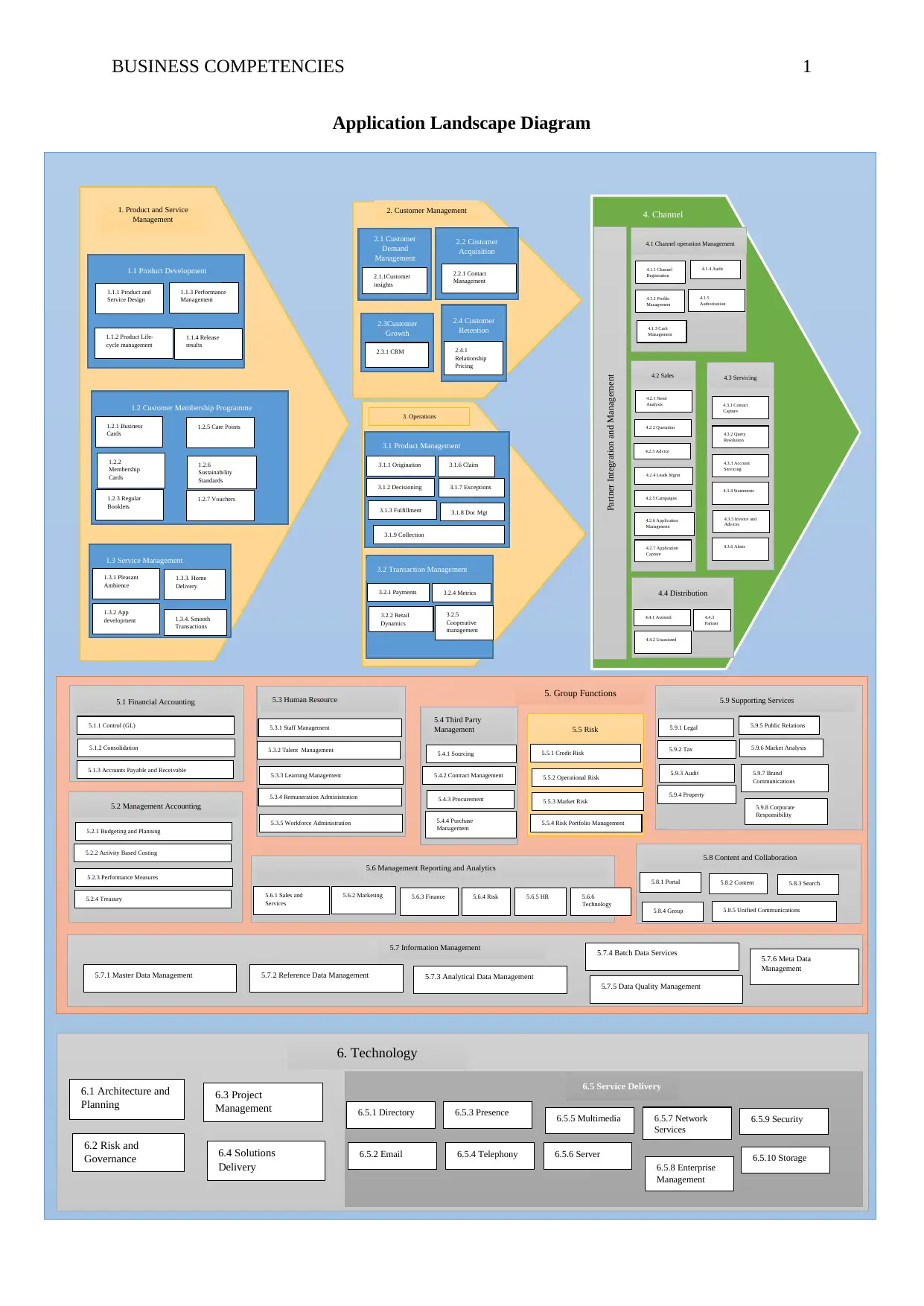
BUSINESS COMPETENCIES 1
Application Landscape Diagram
1.1.1 Product and
Service Design
1.1.3 Performance
Management
1.1.2 Product Life-
cycle management
1.1.4 Release
results
1. Product and Service
Management
1.1 Product Development
1.2 Customer Membership Programme
1.2.1 Business
Cards
1.2.5 Care Points
1.2.2
Membership
Cards
1.2.6
Sustainability
Standards
1.2.3 Regular
Booklets
1.2.7 Vouchers
1.3 Service Management
1.3.1 Pleasant
Ambience
1.3.2 App
development
1.3.3. Home
Delivery
1.3.4. Smooth
Transactions
2.1 Customer
Demand
Management
2. Customer Management
2.1.1Customer
insights
2.2 Customer
Acquisition
2.2.1 Contact
Management
2.3Customer
Growth
2.3.1 CRM
2.4 Customer
Retention
2.4.1
Relationship
Pricing
3. Operations
3.1 Product Management
3.1.1 Origination
3.1.2 Decisioning
3.1.3 Fulfillment
3.1.6 Claim
3.1.7 Exceptions
3.1.8 Doc Mgt
3.1.9 Collection
3.2 Transaction Management
3.2.1 Payments
3.2.2 Retail
Dynamics
3.2.4 Metrics
3.2.5
Cooperative
management
4. Channel
Partner Integration and Management
4.1 Channel operation Management
4.1.1 Channel
Registration
4.1.2 Profile
Management
4.1.3 Cash
Management
4.1.4 Audit
4.1.5
Authorization
4.2 Sales
4.2.1 Need
Analysis
4.3 Servicing
4.3.1 Contact
Capture
4.4 Distribution
4.2.2 Quotation
4.2.3 Advice
4.2.4 Leads Mgmt
4.2.5 Campaigns
4.2.6 Application
Management
4.2.7 Application
Capture
4.3.2 Query
Resolution
4.3.3 Account
Servicing
4.3.4 Statements
4.3.5 Invoice and
Advices
4.3.6 Alerts
4.4.1 Assisted 4.4.3
Partner
4.4.2 Unassisted
5.1 Financial Accounting 5.3 Human Resource
5.4 Third Party
Management
5.9 Supporting Services
5.2 Management Accounting
5.6 Management Reporting and Analytics
5.8 Content and Collaboration
5.7 Information Management
5.5 Risk
5. Group Functions
5.1.1 Control (GL)
5.1.2 Consolidation
5.1.3 Accounts Payable and Receivable
5.2.1 Budgeting and Planning
5.2.2 Activity Based Costing
5.2.3 Performance Measures
5.2.4 Treasury
5.3.1 Staff Management
5.3.2 Talent Management
5.3.3 Learning Management
5.3.4 Remuneration Administration
5.4.1 Sourcing
5.4.2 Contract Management
5.4.3 Procurement
5.4.4 Purchase
Management
5.5.1 Credit Risk
5.5.2 Operational Risk
5.5.3 Market Risk
5.5.4 Risk Portfolio Management5.3.5 Workforce Administration
5.9.1 Legal
5.9.2 Tax
5.9.3 Audit
5.9.4 Property
5.9.5 Public Relations
5.9.6 Market Analysis
5.9.7 Brand
Communications
5.9.8 Corporate
Responsibility
5.6.1 Sales and
Services
5.6.2 Marketing 5.6.3 Finance 5.6.4 Risk 5.6.5 HR 5.6.6
Technology
5.8.1 Portal
5.8.4 Group
Working
5.8.2 Content 5.8.3 Search
5.8.5 Unified Communications
5.7.1 Master Data Management 5.7.2 Reference Data Management 5.7.3 Analytical Data Management
5.7.4 Batch Data Services
5.7.5 Data Quality Management
5.7.6 Meta Data
Management
6. Technology
6.1 Architecture and
Planning
6.2 Risk and
Governance
6.3 Project
Management
6.4 Solutions
Delivery
6.5 Service Delivery
6.5.1 Directory
6.5.2 Email
6.5.3 Presence
6.5.4 Telephony
6.5.5 Multimedia
6.5.6 Server
6.5.7 Network
Services
6.5.8 Enterprise
Management
6.5.9 Security
6.5.10 Storage
Application Landscape Diagram
1.1.1 Product and
Service Design
1.1.3 Performance
Management
1.1.2 Product Life-
cycle management
1.1.4 Release
results
1. Product and Service
Management
1.1 Product Development
1.2 Customer Membership Programme
1.2.1 Business
Cards
1.2.5 Care Points
1.2.2
Membership
Cards
1.2.6
Sustainability
Standards
1.2.3 Regular
Booklets
1.2.7 Vouchers
1.3 Service Management
1.3.1 Pleasant
Ambience
1.3.2 App
development
1.3.3. Home
Delivery
1.3.4. Smooth
Transactions
2.1 Customer
Demand
Management
2. Customer Management
2.1.1Customer
insights
2.2 Customer
Acquisition
2.2.1 Contact
Management
2.3Customer
Growth
2.3.1 CRM
2.4 Customer
Retention
2.4.1
Relationship
Pricing
3. Operations
3.1 Product Management
3.1.1 Origination
3.1.2 Decisioning
3.1.3 Fulfillment
3.1.6 Claim
3.1.7 Exceptions
3.1.8 Doc Mgt
3.1.9 Collection
3.2 Transaction Management
3.2.1 Payments
3.2.2 Retail
Dynamics
3.2.4 Metrics
3.2.5
Cooperative
management
4. Channel
Partner Integration and Management
4.1 Channel operation Management
4.1.1 Channel
Registration
4.1.2 Profile
Management
4.1.3 Cash
Management
4.1.4 Audit
4.1.5
Authorization
4.2 Sales
4.2.1 Need
Analysis
4.3 Servicing
4.3.1 Contact
Capture
4.4 Distribution
4.2.2 Quotation
4.2.3 Advice
4.2.4 Leads Mgmt
4.2.5 Campaigns
4.2.6 Application
Management
4.2.7 Application
Capture
4.3.2 Query
Resolution
4.3.3 Account
Servicing
4.3.4 Statements
4.3.5 Invoice and
Advices
4.3.6 Alerts
4.4.1 Assisted 4.4.3
Partner
4.4.2 Unassisted
5.1 Financial Accounting 5.3 Human Resource
5.4 Third Party
Management
5.9 Supporting Services
5.2 Management Accounting
5.6 Management Reporting and Analytics
5.8 Content and Collaboration
5.7 Information Management
5.5 Risk
5. Group Functions
5.1.1 Control (GL)
5.1.2 Consolidation
5.1.3 Accounts Payable and Receivable
5.2.1 Budgeting and Planning
5.2.2 Activity Based Costing
5.2.3 Performance Measures
5.2.4 Treasury
5.3.1 Staff Management
5.3.2 Talent Management
5.3.3 Learning Management
5.3.4 Remuneration Administration
5.4.1 Sourcing
5.4.2 Contract Management
5.4.3 Procurement
5.4.4 Purchase
Management
5.5.1 Credit Risk
5.5.2 Operational Risk
5.5.3 Market Risk
5.5.4 Risk Portfolio Management5.3.5 Workforce Administration
5.9.1 Legal
5.9.2 Tax
5.9.3 Audit
5.9.4 Property
5.9.5 Public Relations
5.9.6 Market Analysis
5.9.7 Brand
Communications
5.9.8 Corporate
Responsibility
5.6.1 Sales and
Services
5.6.2 Marketing 5.6.3 Finance 5.6.4 Risk 5.6.5 HR 5.6.6
Technology
5.8.1 Portal
5.8.4 Group
Working
5.8.2 Content 5.8.3 Search
5.8.5 Unified Communications
5.7.1 Master Data Management 5.7.2 Reference Data Management 5.7.3 Analytical Data Management
5.7.4 Batch Data Services
5.7.5 Data Quality Management
5.7.6 Meta Data
Management
6. Technology
6.1 Architecture and
Planning
6.2 Risk and
Governance
6.3 Project
Management
6.4 Solutions
Delivery
6.5 Service Delivery
6.5.1 Directory
6.5.2 Email
6.5.3 Presence
6.5.4 Telephony
6.5.5 Multimedia
6.5.6 Server
6.5.7 Network
Services
6.5.8 Enterprise
Management
6.5.9 Security
6.5.10 Storage
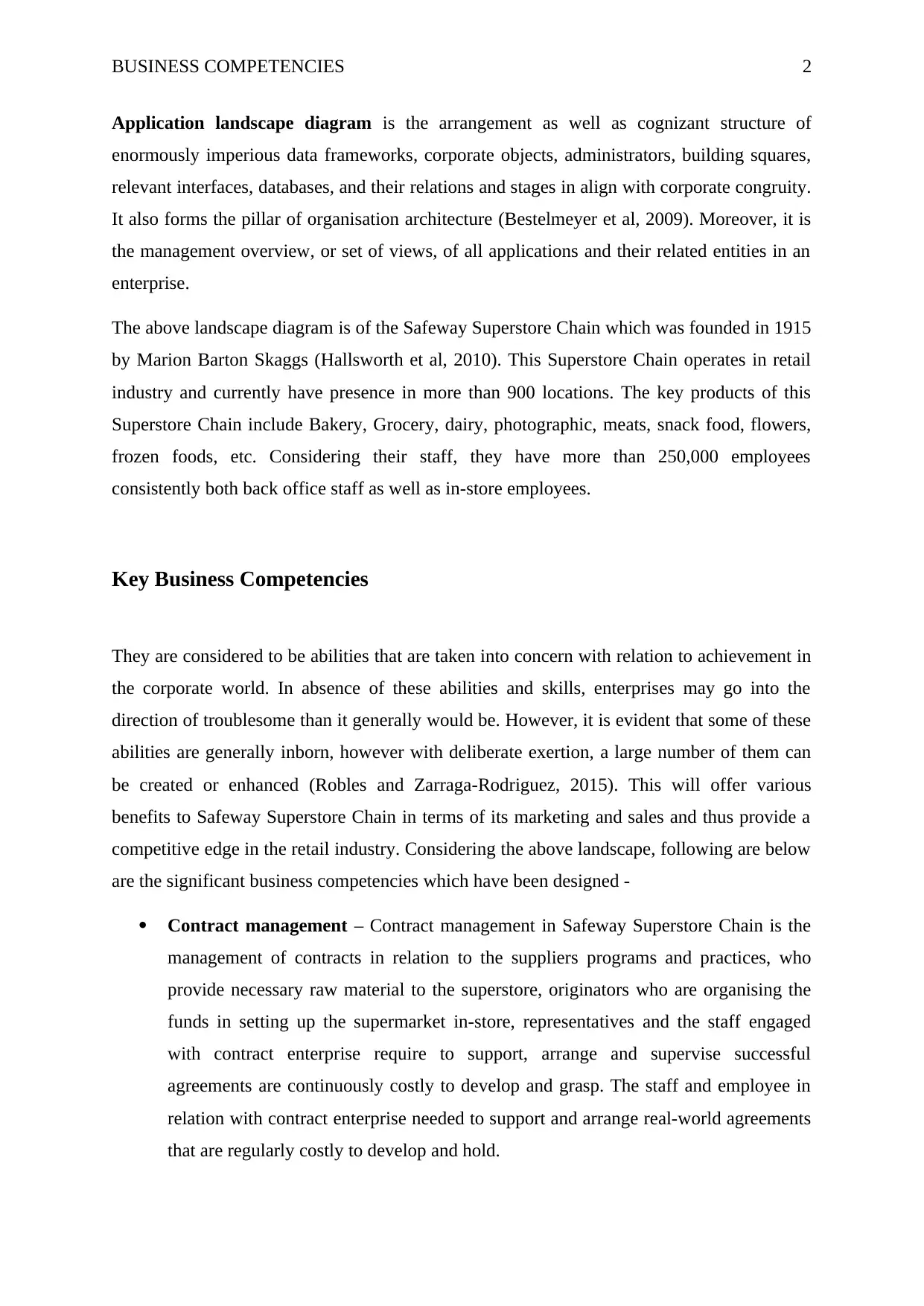
BUSINESS COMPETENCIES 2
Application landscape diagram is the arrangement as well as cognizant structure of
enormously imperious data frameworks, corporate objects, administrators, building squares,
relevant interfaces, databases, and their relations and stages in align with corporate congruity.
It also forms the pillar of organisation architecture (Bestelmeyer et al, 2009). Moreover, it is
the management overview, or set of views, of all applications and their related entities in an
enterprise.
The above landscape diagram is of the Safeway Superstore Chain which was founded in 1915
by Marion Barton Skaggs (Hallsworth et al, 2010). This Superstore Chain operates in retail
industry and currently have presence in more than 900 locations. The key products of this
Superstore Chain include Bakery, Grocery, dairy, photographic, meats, snack food, flowers,
frozen foods, etc. Considering their staff, they have more than 250,000 employees
consistently both back office staff as well as in-store employees.
Key Business Competencies
They are considered to be abilities that are taken into concern with relation to achievement in
the corporate world. In absence of these abilities and skills, enterprises may go into the
direction of troublesome than it generally would be. However, it is evident that some of these
abilities are generally inborn, however with deliberate exertion, a large number of them can
be created or enhanced (Robles and Zarraga-Rodriguez, 2015). This will offer various
benefits to Safeway Superstore Chain in terms of its marketing and sales and thus provide a
competitive edge in the retail industry. Considering the above landscape, following are below
are the significant business competencies which have been designed -
Contract management – Contract management in Safeway Superstore Chain is the
management of contracts in relation to the suppliers programs and practices, who
provide necessary raw material to the superstore, originators who are organising the
funds in setting up the supermarket in-store, representatives and the staff engaged
with contract enterprise require to support, arrange and supervise successful
agreements are continuously costly to develop and grasp. The staff and employee in
relation with contract enterprise needed to support and arrange real-world agreements
that are regularly costly to develop and hold.
Application landscape diagram is the arrangement as well as cognizant structure of
enormously imperious data frameworks, corporate objects, administrators, building squares,
relevant interfaces, databases, and their relations and stages in align with corporate congruity.
It also forms the pillar of organisation architecture (Bestelmeyer et al, 2009). Moreover, it is
the management overview, or set of views, of all applications and their related entities in an
enterprise.
The above landscape diagram is of the Safeway Superstore Chain which was founded in 1915
by Marion Barton Skaggs (Hallsworth et al, 2010). This Superstore Chain operates in retail
industry and currently have presence in more than 900 locations. The key products of this
Superstore Chain include Bakery, Grocery, dairy, photographic, meats, snack food, flowers,
frozen foods, etc. Considering their staff, they have more than 250,000 employees
consistently both back office staff as well as in-store employees.
Key Business Competencies
They are considered to be abilities that are taken into concern with relation to achievement in
the corporate world. In absence of these abilities and skills, enterprises may go into the
direction of troublesome than it generally would be. However, it is evident that some of these
abilities are generally inborn, however with deliberate exertion, a large number of them can
be created or enhanced (Robles and Zarraga-Rodriguez, 2015). This will offer various
benefits to Safeway Superstore Chain in terms of its marketing and sales and thus provide a
competitive edge in the retail industry. Considering the above landscape, following are below
are the significant business competencies which have been designed -
Contract management – Contract management in Safeway Superstore Chain is the
management of contracts in relation to the suppliers programs and practices, who
provide necessary raw material to the superstore, originators who are organising the
funds in setting up the supermarket in-store, representatives and the staff engaged
with contract enterprise require to support, arrange and supervise successful
agreements are continuously costly to develop and grasp. The staff and employee in
relation with contract enterprise needed to support and arrange real-world agreements
that are regularly costly to develop and hold.
⊘ This is a preview!⊘
Do you want full access?
Subscribe today to unlock all pages.

Trusted by 1+ million students worldwide
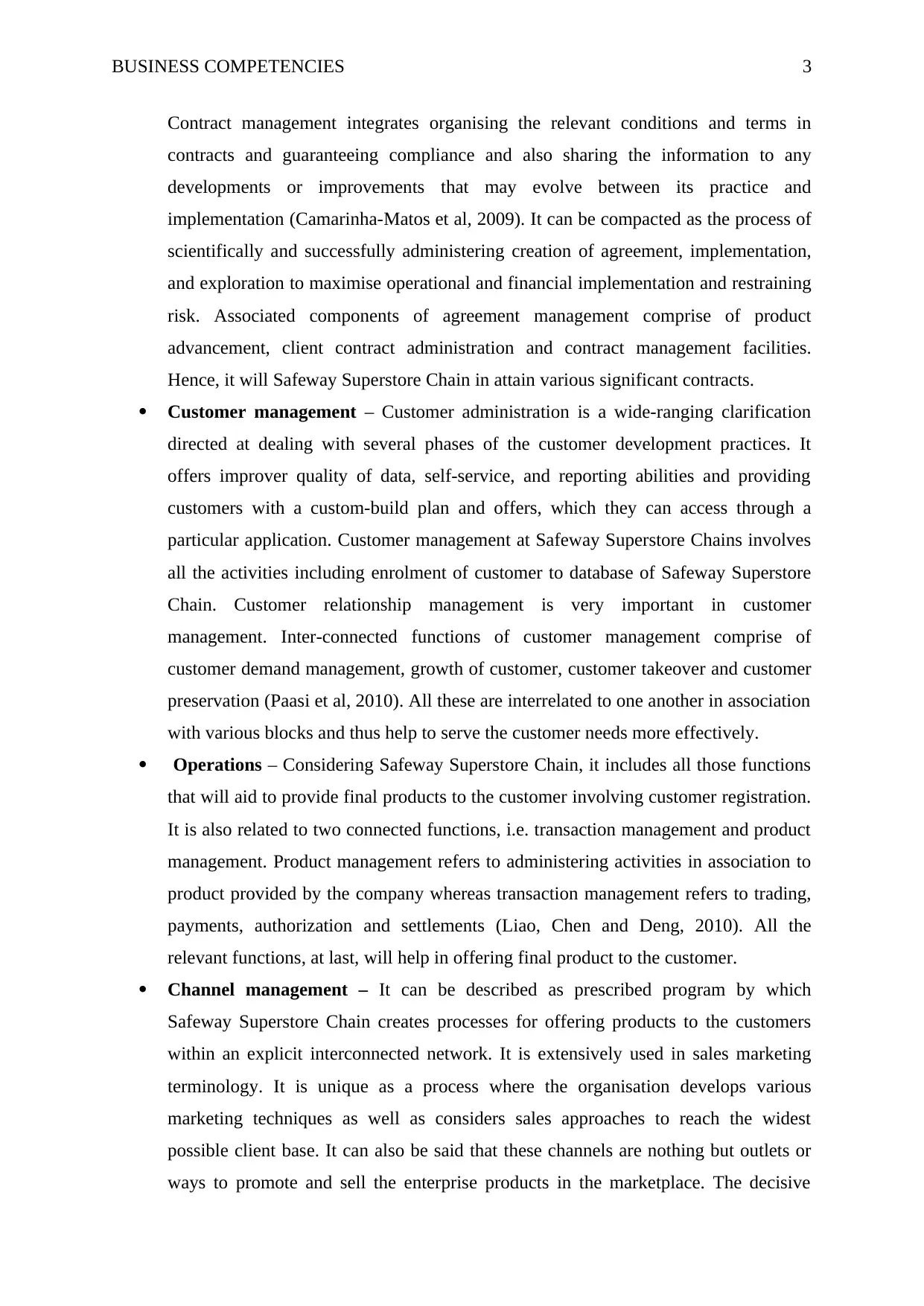
BUSINESS COMPETENCIES 3
Contract management integrates organising the relevant conditions and terms in
contracts and guaranteeing compliance and also sharing the information to any
developments or improvements that may evolve between its practice and
implementation (Camarinha-Matos et al, 2009). It can be compacted as the process of
scientifically and successfully administering creation of agreement, implementation,
and exploration to maximise operational and financial implementation and restraining
risk. Associated components of agreement management comprise of product
advancement, client contract administration and contract management facilities.
Hence, it will Safeway Superstore Chain in attain various significant contracts.
Customer management – Customer administration is a wide-ranging clarification
directed at dealing with several phases of the customer development practices. It
offers improver quality of data, self-service, and reporting abilities and providing
customers with a custom-build plan and offers, which they can access through a
particular application. Customer management at Safeway Superstore Chains involves
all the activities including enrolment of customer to database of Safeway Superstore
Chain. Customer relationship management is very important in customer
management. Inter-connected functions of customer management comprise of
customer demand management, growth of customer, customer takeover and customer
preservation (Paasi et al, 2010). All these are interrelated to one another in association
with various blocks and thus help to serve the customer needs more effectively.
Operations – Considering Safeway Superstore Chain, it includes all those functions
that will aid to provide final products to the customer involving customer registration.
It is also related to two connected functions, i.e. transaction management and product
management. Product management refers to administering activities in association to
product provided by the company whereas transaction management refers to trading,
payments, authorization and settlements (Liao, Chen and Deng, 2010). All the
relevant functions, at last, will help in offering final product to the customer.
Channel management – It can be described as prescribed program by which
Safeway Superstore Chain creates processes for offering products to the customers
within an explicit interconnected network. It is extensively used in sales marketing
terminology. It is unique as a process where the organisation develops various
marketing techniques as well as considers sales approaches to reach the widest
possible client base. It can also be said that these channels are nothing but outlets or
ways to promote and sell the enterprise products in the marketplace. The decisive
Contract management integrates organising the relevant conditions and terms in
contracts and guaranteeing compliance and also sharing the information to any
developments or improvements that may evolve between its practice and
implementation (Camarinha-Matos et al, 2009). It can be compacted as the process of
scientifically and successfully administering creation of agreement, implementation,
and exploration to maximise operational and financial implementation and restraining
risk. Associated components of agreement management comprise of product
advancement, client contract administration and contract management facilities.
Hence, it will Safeway Superstore Chain in attain various significant contracts.
Customer management – Customer administration is a wide-ranging clarification
directed at dealing with several phases of the customer development practices. It
offers improver quality of data, self-service, and reporting abilities and providing
customers with a custom-build plan and offers, which they can access through a
particular application. Customer management at Safeway Superstore Chains involves
all the activities including enrolment of customer to database of Safeway Superstore
Chain. Customer relationship management is very important in customer
management. Inter-connected functions of customer management comprise of
customer demand management, growth of customer, customer takeover and customer
preservation (Paasi et al, 2010). All these are interrelated to one another in association
with various blocks and thus help to serve the customer needs more effectively.
Operations – Considering Safeway Superstore Chain, it includes all those functions
that will aid to provide final products to the customer involving customer registration.
It is also related to two connected functions, i.e. transaction management and product
management. Product management refers to administering activities in association to
product provided by the company whereas transaction management refers to trading,
payments, authorization and settlements (Liao, Chen and Deng, 2010). All the
relevant functions, at last, will help in offering final product to the customer.
Channel management – It can be described as prescribed program by which
Safeway Superstore Chain creates processes for offering products to the customers
within an explicit interconnected network. It is extensively used in sales marketing
terminology. It is unique as a process where the organisation develops various
marketing techniques as well as considers sales approaches to reach the widest
possible client base. It can also be said that these channels are nothing but outlets or
ways to promote and sell the enterprise products in the marketplace. The decisive
Paraphrase This Document
Need a fresh take? Get an instant paraphrase of this document with our AI Paraphraser
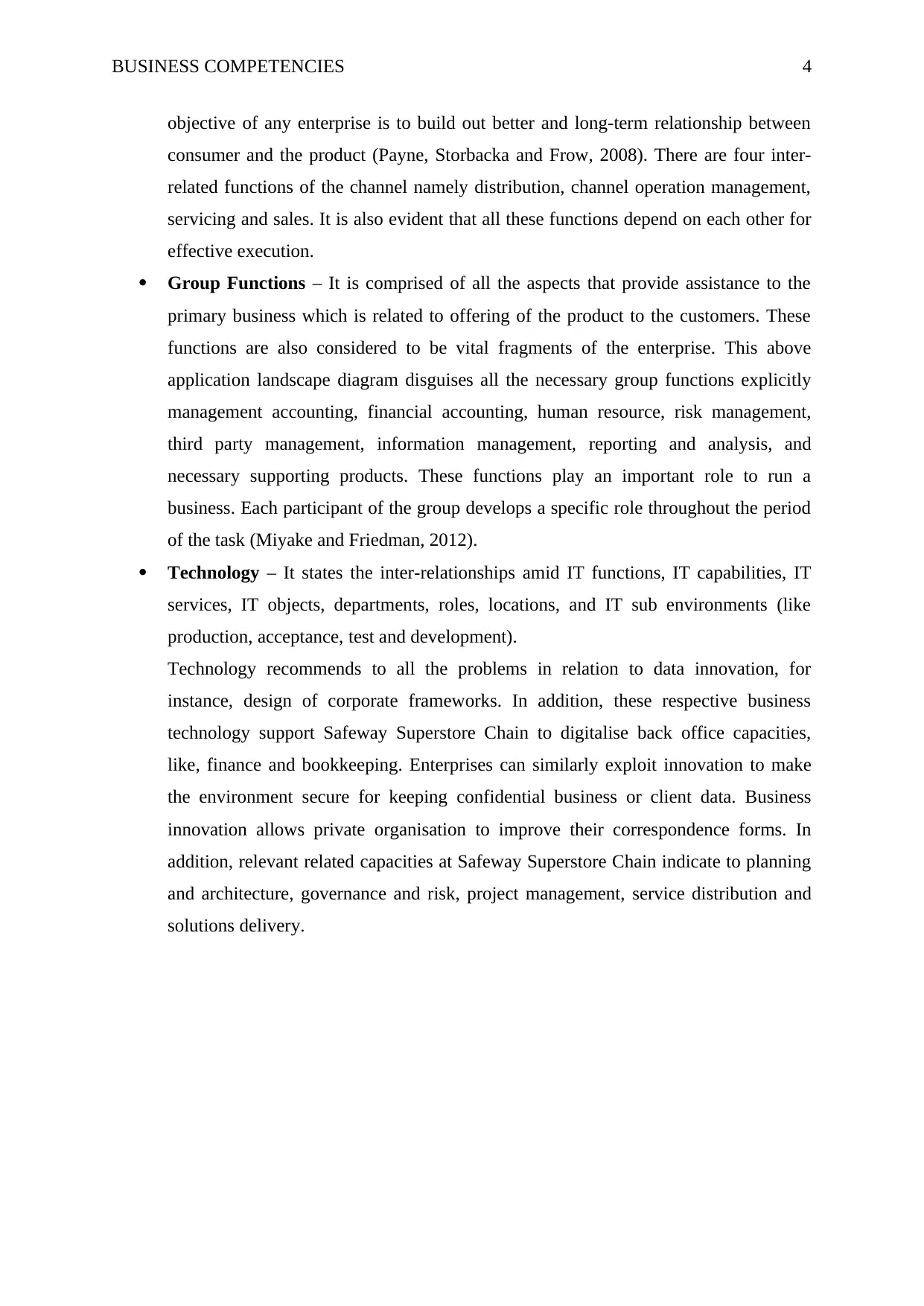
BUSINESS COMPETENCIES 4
objective of any enterprise is to build out better and long-term relationship between
consumer and the product (Payne, Storbacka and Frow, 2008). There are four inter-
related functions of the channel namely distribution, channel operation management,
servicing and sales. It is also evident that all these functions depend on each other for
effective execution.
Group Functions – It is comprised of all the aspects that provide assistance to the
primary business which is related to offering of the product to the customers. These
functions are also considered to be vital fragments of the enterprise. This above
application landscape diagram disguises all the necessary group functions explicitly
management accounting, financial accounting, human resource, risk management,
third party management, information management, reporting and analysis, and
necessary supporting products. These functions play an important role to run a
business. Each participant of the group develops a specific role throughout the period
of the task (Miyake and Friedman, 2012).
Technology – It states the inter-relationships amid IT functions, IT capabilities, IT
services, IT objects, departments, roles, locations, and IT sub environments (like
production, acceptance, test and development).
Technology recommends to all the problems in relation to data innovation, for
instance, design of corporate frameworks. In addition, these respective business
technology support Safeway Superstore Chain to digitalise back office capacities,
like, finance and bookkeeping. Enterprises can similarly exploit innovation to make
the environment secure for keeping confidential business or client data. Business
innovation allows private organisation to improve their correspondence forms. In
addition, relevant related capacities at Safeway Superstore Chain indicate to planning
and architecture, governance and risk, project management, service distribution and
solutions delivery.
objective of any enterprise is to build out better and long-term relationship between
consumer and the product (Payne, Storbacka and Frow, 2008). There are four inter-
related functions of the channel namely distribution, channel operation management,
servicing and sales. It is also evident that all these functions depend on each other for
effective execution.
Group Functions – It is comprised of all the aspects that provide assistance to the
primary business which is related to offering of the product to the customers. These
functions are also considered to be vital fragments of the enterprise. This above
application landscape diagram disguises all the necessary group functions explicitly
management accounting, financial accounting, human resource, risk management,
third party management, information management, reporting and analysis, and
necessary supporting products. These functions play an important role to run a
business. Each participant of the group develops a specific role throughout the period
of the task (Miyake and Friedman, 2012).
Technology – It states the inter-relationships amid IT functions, IT capabilities, IT
services, IT objects, departments, roles, locations, and IT sub environments (like
production, acceptance, test and development).
Technology recommends to all the problems in relation to data innovation, for
instance, design of corporate frameworks. In addition, these respective business
technology support Safeway Superstore Chain to digitalise back office capacities,
like, finance and bookkeeping. Enterprises can similarly exploit innovation to make
the environment secure for keeping confidential business or client data. Business
innovation allows private organisation to improve their correspondence forms. In
addition, relevant related capacities at Safeway Superstore Chain indicate to planning
and architecture, governance and risk, project management, service distribution and
solutions delivery.
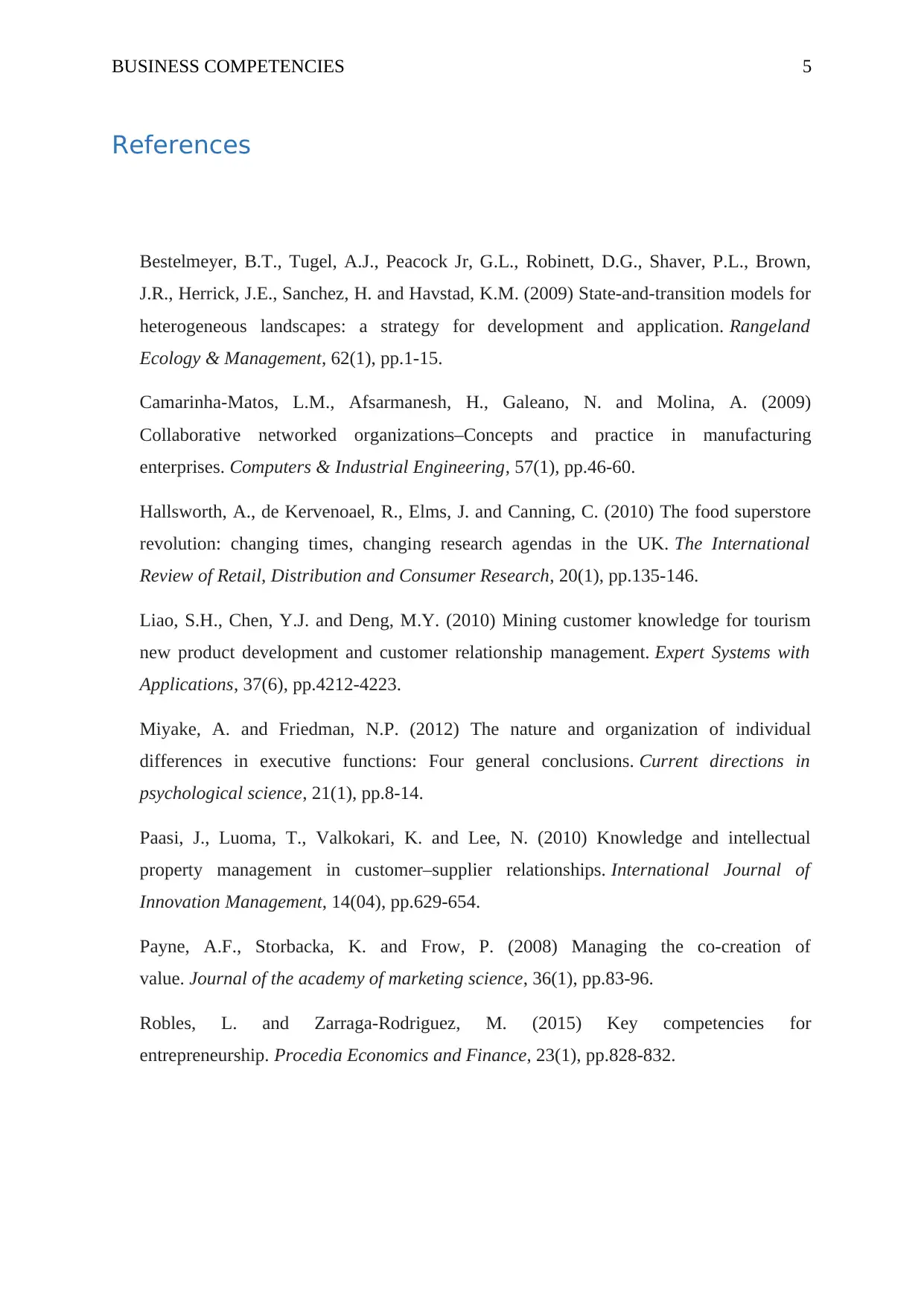
BUSINESS COMPETENCIES 5
References
Bestelmeyer, B.T., Tugel, A.J., Peacock Jr, G.L., Robinett, D.G., Shaver, P.L., Brown,
J.R., Herrick, J.E., Sanchez, H. and Havstad, K.M. (2009) State-and-transition models for
heterogeneous landscapes: a strategy for development and application. Rangeland
Ecology & Management, 62(1), pp.1-15.
Camarinha-Matos, L.M., Afsarmanesh, H., Galeano, N. and Molina, A. (2009)
Collaborative networked organizations–Concepts and practice in manufacturing
enterprises. Computers & Industrial Engineering, 57(1), pp.46-60.
Hallsworth, A., de Kervenoael, R., Elms, J. and Canning, C. (2010) The food superstore
revolution: changing times, changing research agendas in the UK. The International
Review of Retail, Distribution and Consumer Research, 20(1), pp.135-146.
Liao, S.H., Chen, Y.J. and Deng, M.Y. (2010) Mining customer knowledge for tourism
new product development and customer relationship management. Expert Systems with
Applications, 37(6), pp.4212-4223.
Miyake, A. and Friedman, N.P. (2012) The nature and organization of individual
differences in executive functions: Four general conclusions. Current directions in
psychological science, 21(1), pp.8-14.
Paasi, J., Luoma, T., Valkokari, K. and Lee, N. (2010) Knowledge and intellectual
property management in customer–supplier relationships. International Journal of
Innovation Management, 14(04), pp.629-654.
Payne, A.F., Storbacka, K. and Frow, P. (2008) Managing the co-creation of
value. Journal of the academy of marketing science, 36(1), pp.83-96.
Robles, L. and Zarraga-Rodriguez, M. (2015) Key competencies for
entrepreneurship. Procedia Economics and Finance, 23(1), pp.828-832.
References
Bestelmeyer, B.T., Tugel, A.J., Peacock Jr, G.L., Robinett, D.G., Shaver, P.L., Brown,
J.R., Herrick, J.E., Sanchez, H. and Havstad, K.M. (2009) State-and-transition models for
heterogeneous landscapes: a strategy for development and application. Rangeland
Ecology & Management, 62(1), pp.1-15.
Camarinha-Matos, L.M., Afsarmanesh, H., Galeano, N. and Molina, A. (2009)
Collaborative networked organizations–Concepts and practice in manufacturing
enterprises. Computers & Industrial Engineering, 57(1), pp.46-60.
Hallsworth, A., de Kervenoael, R., Elms, J. and Canning, C. (2010) The food superstore
revolution: changing times, changing research agendas in the UK. The International
Review of Retail, Distribution and Consumer Research, 20(1), pp.135-146.
Liao, S.H., Chen, Y.J. and Deng, M.Y. (2010) Mining customer knowledge for tourism
new product development and customer relationship management. Expert Systems with
Applications, 37(6), pp.4212-4223.
Miyake, A. and Friedman, N.P. (2012) The nature and organization of individual
differences in executive functions: Four general conclusions. Current directions in
psychological science, 21(1), pp.8-14.
Paasi, J., Luoma, T., Valkokari, K. and Lee, N. (2010) Knowledge and intellectual
property management in customer–supplier relationships. International Journal of
Innovation Management, 14(04), pp.629-654.
Payne, A.F., Storbacka, K. and Frow, P. (2008) Managing the co-creation of
value. Journal of the academy of marketing science, 36(1), pp.83-96.
Robles, L. and Zarraga-Rodriguez, M. (2015) Key competencies for
entrepreneurship. Procedia Economics and Finance, 23(1), pp.828-832.
⊘ This is a preview!⊘
Do you want full access?
Subscribe today to unlock all pages.

Trusted by 1+ million students worldwide
1 out of 6
Related Documents
Your All-in-One AI-Powered Toolkit for Academic Success.
+13062052269
info@desklib.com
Available 24*7 on WhatsApp / Email
![[object Object]](/_next/static/media/star-bottom.7253800d.svg)
Unlock your academic potential
Copyright © 2020–2025 A2Z Services. All Rights Reserved. Developed and managed by ZUCOL.





